Comments
Header
News from Shin Kaze
November 2024
Shin Kaze Aikido Alliance is an organization dedicated to the practice and development of
Aikido. It aims to provide technical and administrative guidance to Aikido practitioners and
to maintain standards of practice and instruction within an egalitarian and tolerant structure.
|
|
Table of Contents
Introduction
Introduction
A warm welcome to the November 2024 edition of the Shin Kaze newsletter.
In this issue, we include several articles on
the experience of participants in seminars and summer camps,
a new installment from Kanai Sensei's book "Technical Aikido",
an article on martial arts practice and the importance of returning to the beginner's mind,
an article on movement and resistance,
a brief article introducing a new section to be included in future newsletters focusing on younger Aikidoists,
and a reprint of an article on reporting Aikido injuries.
We are also happy to report that 8 dojos have recently become Full Members.
We strongly encourage communication between all our members,
and sharing your thoughts about our wonderful art of Aikido is a great way to enhance our connection.
We hope you will enjoy this issue and that you will feel motivated to contribute an article - or two - of your own
for publication in the future.
|
|
Art. 2
The Importance of Seminars
By
Michel Casanova Casanova
Dojo-cho Morihiro Saito Dojo, Cuba

Aikido as a Martial Art is sometimes criticized for not having competitions by weight or division,
nor tournaments where champions or medalists are established. Those who think this way misunderstand
the concept of the Art. Aikido is a discipline for spiritual growth and not for exalting egos or measuring abilities.
It is an activity for learning and constant improvement.
If this is the case, how do we know where we're going? How do we know if what we do is right or wrong?
Together with our teacher's guidance there are seminars to help us improve ourselves.
These provide an appropriate space and time to examine what we have learned and continue to forge ahead,
to share with others outside our dojo, exchange experiences and learn much more.
Seminars are one of the most effective ways to approach great teachers, correct some mistakes, reaffirm what we have learned
and fill us with joy and motivation.
Many times in seminars we are tested as uke and as a nage, which leads us to reassess the ways we do things,
from the most basic, to the understanding of concepts and ideas underlying the philosophy of art.
One almost always learns new and interesting things.
It is exciting to be reunited with many other practitioners, sometimes from different places, cultures, schools, ages, levels;
to practice and share the gift O-Sensei gave to humanity.
At seminars we are exposed to new projects and ideas, we make new acquaintances and friends, we compare and emulate behaviors,
we forge new alliances, we sometimes leave with satisfaction or eagerness, we have memories left.
Attending these events makes us plan, takes us out of our comfort zone; tests our solidarity, temper, discipline,
perseverance and commitment.
They also lend themselves as an opportunity to conduct examinations. In those instances, there are moments of
tension and strong emotions, and under those circumstances, examinations can be compared to competitions.
Sometimes we experience anecdotes that make us laugh and reflect. Surely this has happened to many of us, and
I invite you to remember and share them. Let me tell you two of my own.
On one occasion I attended a seminar in the company of one of my students, who had been practicing for a short time.
I invited him in order to motivate him and so he would attend his first seminar.
We were relatively close to each other so as to be able to practice together, and at the time of practice he constantly wondered out loud:
How do I do this? How do I do that? Why can't I get the technique?"
Of course this caused disruption and I couldn't concentrate.
The Sensei leading the seminar noticed the situation and began approaching, explaining and gradually correcting each of the
practitioners along the way to us. When he was quite close, my student insisted again with his doubts so I told him,
"Ask the Sensei." He thought for a few moments and then went towards O-Sensei's portrait, stood in front of it,
bowed and began performing the technique. I immediately realized he did not understand what I had told him.
In another recent seminar the Shihan leading it demonstrated a new and interesting technique, typical of his teacher's legacy.
Before I started practicing, I left the mat to write down the name of that technique so that I wouldn't forget it
and to be able to find details about it later. Upon returning to the mat I found that almost everyone
already had a partner and were busy practicing, so I stayed in the middle of the mat a little disoriented.
The Shihan looked at me as if asking me, "Why aren't you doing anything?" So I went to him and said,
"I don't have a practice partner." Then with his wise experience he whispered in my ear: "Go with the beginners".
He taught me a lesson in humility. Not only did I realize that he was fully aware of everything that was happening on the mat,
but he cared about everyone at the seminar. And indeed, among the beginners I found someone to practice with.
|
|
Art. 3
Our First Summer Camp
By
Fukushidoin Leonel Sánchez Sotolongo
Dojo-cho Kan Sho Ryu Dojo, Cuba
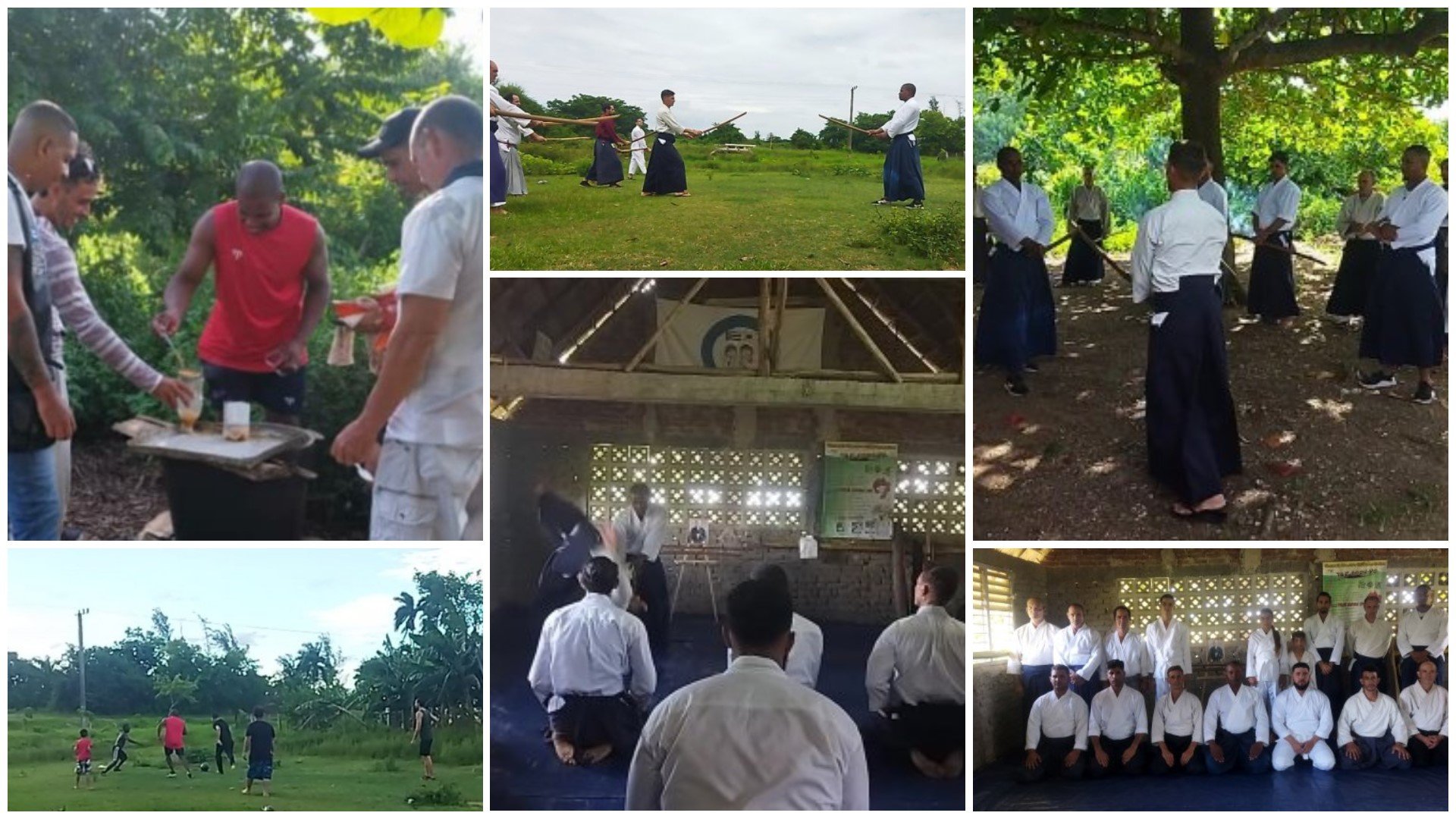
Last August, the first Cuba Kan Sho Ryu Summer Camp took place in the rural community of Tajadora, in the municipality of
Cifuentes. For two days, practitioners from three municipalities where dojos that are members of Shin Kaze Aikido Alliance
are located met at the Taekwondo Gymnasium in this town and participated in Aikido and Iaido classes.
Outside of practice hours, various recreational and social activities in contact with nature were carried out for the
enjoyment of the children, youth and adults present. Soccer, dominoes and the preparation of a typical Cuban soup were the
main attractions.
A very special moment that moved everyone present was when messages sent by the members of Kan Sho Ryu Dojo who have
emigrated to other countries were played, as well as messages from our great friend Jesús Alberto Loyo Quiñones and from
Robert Zimmermann Shihan, with words that encouraged us to continue on the path, overcoming any obstacle that may stand in
our way.
An event of this kind was unprecedented in our country. We came out stronger, with greater cohesion and very encouraged. Once
again we have shown that when you work as a team, with love for what you do and under the right guidance, you can achieve
many things.
We will begin to organize a Winter Camp for the month of December, everyone is invited to enjoy this magnificent experience.
|
|
Art. 8
From Aikido in High School to Aikido in Strasbourg
By
Sofia Encarnação
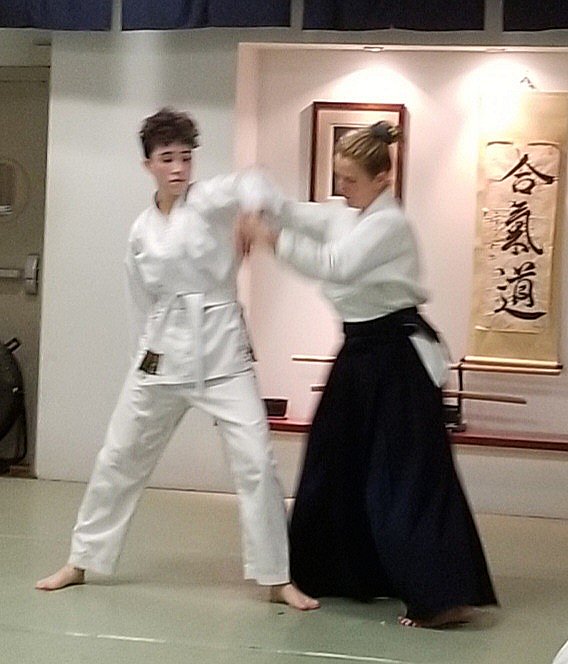
I was only seventeen and looking for a method of exercise to challenge myself with when I fell in love with Aikido.
I became intrigued by how different the techniques felt from other martial arts I have seen.
I grew up dancing and there were so many aspects of Aikido that mirrored my interests in dance: body awareness and connection,
discipline, harnessing energy, being strong yet soft.
It is incredible to see people be thrown so gracefully, making the martial art look like a dance.
Though sometimes I feel far from graceful while practicing, I enjoy the flow of movement and how so many techniques connect
fluidly like water. I greatly admire the discipline and respect that Aikido teaches.
I find it fascinating to see how far Aikido has gone beyond its origins in Japan and how it can bring so many people together
all over the world. I never would have imagined myself traveling to other countries to be thrown on the ground by strangers
but Aikido has opened up such incredible opportunities.
Last year I traveled with my Sensei Fiona Blyth to Strasbourg, France, and attended a seminar there. I was able to meet
Gabriel Valibouze Sensei and train with people even if we didn’t speak the same language because we were united by our interest
in Aikido. There so many different styles of Aikido and it is amazing to experience what different teachers have to offer and
to try and incorporate them into your own practice.
I am so grateful for all the people I have been able to meet through Aikido and the knowledge I have learned on the mat as well
as off the mat!
|
|
Art. 9
AFA Aikido Summer Camp 2024 at Spa, Belgium
By
Jingting Long
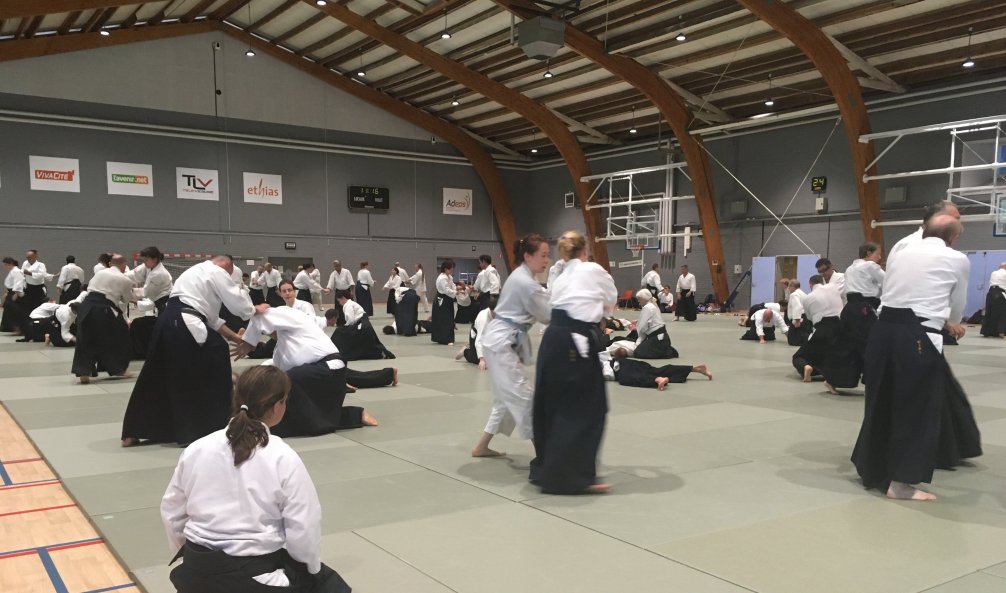
I began practicing Aikido in 2018 after my sister’s dojo reached out to recruit new members.
Having grown up watching impressive Wuxia and Kung Fu movies, I had always been fascinated by martial arts,
but I had never taken a class myself. Curious about Aikido, I did some research and discovered that its
philosophy shares similarities with the principles of Buddhism and Daoism—belief systems that have deeply
influenced my life.
There have been many challenges on my Aikido journey that have pulled me away from regular practice:
demanding work schedules, graduate schoolwork, the long commute to the dojo, unexpected injuries, three years
of the pandemic, bad weather days, and the harsh New England winters. Some of these are genuine obstacles,
while others are simply excuses for my own laziness. Finally, in November 2022, I managed to pass the
5th Kyu test, thanks to the invaluable help and generous support of my Sensei and fellow Aikido members.
I first heard about the AFA Summer Camp from Fiona Blyth in 2022. I was thinking about attending the
2023 camp, but two months before it began, I fractured my foot at work and had to postpone my trip.
Fiona asked me again in 2024 and offered a lot of encouragement. I was hesitant because I hadn’t traveled
since 2019, had never been to Europe, didn’t speak the language, and my foot was still not fully healed.
Despite these concerns, I decided to give it a try. I promised myself to take it easy: skip classes if
necessary, and return home safely in one piece.
With so much help from Fiona and her friends, we managed our trip to Spa. We stayed at the Adeps Olympic Center,
where we would spend the next seven days practicing Aikido with people from all over the world. Despite the
exhausting travel, our arrival was soothed by a delicious three-course dinner prepared by the talented chef
and his kitchen staff. This exquisite meal, served every evening for the next week, was thoughtfully balanced
and creatively prepared. The kitchen team’s attention to detail was remarkable; they remembered all the special
requests and prepared each dish with care and love. The hospitality we experienced was truly beyond words.
The camp was very well organized by President Benoit Toulotte and his team. Aikido practice, or Keiko (稽古),
took place twice daily. The morning session began at 10:00, followed by an afternoon session at 3:00, with
a lunch break in between. Each session lasted an hour and a half. Miyamoto (宮本) Shihan from Honbu (本部),
Japan, led the training for all seven days. His movements were clean and effective, embodying a blend of
softness and power. After each demonstration, he would walk around the dojo, offering hands-on instruction
to as many individuals as possible. If he noticed any misunderstandings of the techniques, he would call
the group together to clarify the movements with detailed explanations.
All instructions were delivered in Japanese, with simultaneous interpretation in French. My limited understanding
of Japanese and lack of knowledge of French made it challenging to follow everything. Thankfully, Fiona would sit
next to me, providing a simultaneous translation from French to English, which allowed me to get the most out of
the practice.
Each class was packed with over a hundred participants, and it was incredible to see people from all over the
world practicing together. There are many good stories I heard at the Camp. One fellow participant from the
camp shared a story of a student asking an Aikido Sensei the same question, 'How long does it take to get a
black belt?' The Sensei jokingly replied, “Do you need a black belt? I have a few lying around. I can cut one
for you. How much do you need?” Another participant Mireille from the camp shared her story with me. She began
practicing Aikido thirty-five years ago, but her training wasn't continuous. She started as a student, but after
graduating and beginning her professional career, she took a break. She resumed for a while but then paused again
when she became pregnant with her first child and later, her second. After her children grew up, she returned to
Aikido once more. Someone once told her that life is like a maze and that there is a thread to guide you to the
exit, which you should hold on to and never let go. She came to realize that Aikido was that thread in her
life—something that has always been there for her and that she will never let go of.
In the end, I survived the whole summer camp without missing a single class! There is so much more I want to share
but could not fit into the limited space here: outdoor activities after dinner, friendly moments chatting together,
drinks, Spa surrounded by trees on top of the wooded mountain, lots and lots of beautiful small flowers, fields
after fields wild berries, evenings playing board games, a friendly priced convenience store with possibly everything
you need for daily life! A farewell party with singing and dancing before the end of the camp, meeting friends, old
friends reuniting and making new friends. It was such a special experience and an unforgettable trip for me. If my
experience has inspired you, I would highly recommend that you try it yourself.
|
|
Comics
Comics - Aikido Animals: The Super Uke
By Jutta Bossert
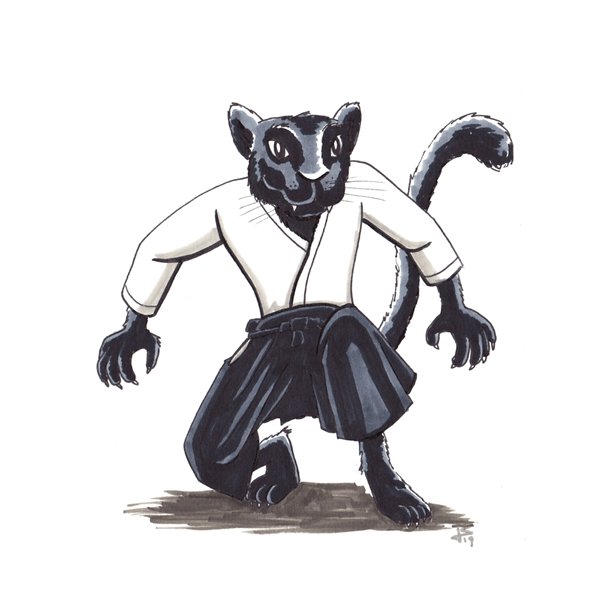
The Super Uke – Their ukemi is beautiful and adaptive.
Everybody wants them as a partner, so you are really lucky to catch one.
© Jutta Bossert - Used by permission.
|
|
Art. 6
Book Corner: Technical Aikido
By Mitsunari Kanai Shihan, 8th Dan
Chief Instructor of New England Aikikai (1966-2004)
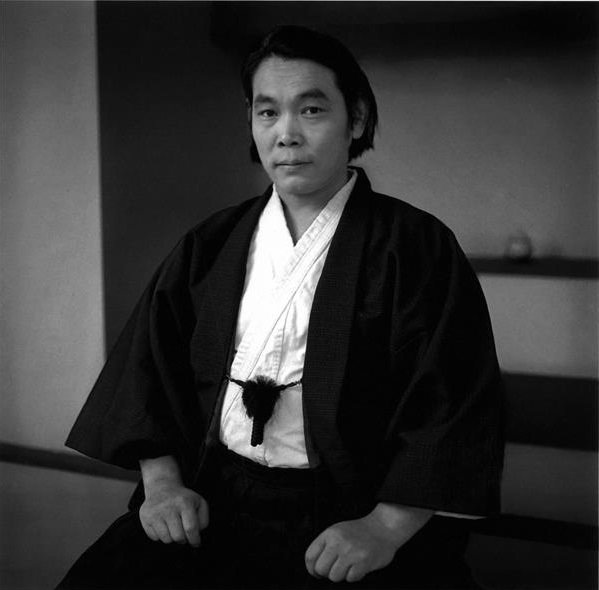
Editor's note: In this "Book Corner" we provide installments of books relevant to our practice.
Following is Part 3 of Chapter 4 of Mitsunari Kanai Shihan's book "Technical Aikido".
CHAPTER 4 - RELATIONSHIP BETWEEN JOINTS AND POWER, AND HOW POWER IS PRODUCED - (Part 1)
We will now examine the relationship between the body's joints and power, and how correct use of the body's joints produces power.
In examining this subject, we can begin to understand the expression of AIKIDO on the physical level, and by focusing on the nature of the body, understand the concept of unification of mind, body and spirit
The concept of unification has suffered because it has usually been a very vague concept. In the past, emphasis on the mind aspect of unification (mainly "how-to-use-KI" ideas) has been used to compensate for the fundamental contradictions and appearance of disunity of AIKIDO's widely varied collection of attacks, joint techniques and throwing techniques
However, as I hope is becoming clear through the previous discussion, it is my belief that by analyzing the workings of the body, a clear and effective logic can be defined and established for AIKIDO practice.
If we use the logic of the physical body as a basis for clarifying what would otherwise be the vague concept of "unification",
we can begin to clarify one's understanding, and escape the ambiguities
in most past concepts. In order to gain this much deeper understanding of AIKIDO, you must learn to use your "entire-self" in AIKIDO practice.
Expressed in physical terms, using your entire-self means that you must use your entire body in performing each movement or technique. Moreover, since the joints are the structures that connect the various parts of the body you must use all of the joints of your body. To do this you must understand the function of the joints of the human body.
There are three important functions of the joints:
First, appropriate and flexible joint movement can soften or avoid a collision with an opponent's power.
Second, joints can create flexibility. Each individual joint has a range of motion, but in order to maximize total body flexibility, one must make all of the joints, including the hip joints, adjust from moment to moment. The more joints that can be adjusted in a coordinated way, the more the body will be totally flexible.
Third, joints can produce power. Muscles create power, and multiple muscles and their associated connective tendons are attached to each joint. When multiple muscles are used in an organized way, the power created necessarily must be proportional to the number of muscles used. This power is manifested through a movement of the joint to which the muscles are connected. If this is true of one joint, then it is better to use two joints than one, and three joints than two, etc. The more joints one uses, the greater the power one can generate and transfer to the opponent.
End of Part 1.
CHAPTER 4 - RELATIONSHIP BETWEEN JOINTS AND POWER, AND HOW POWER IS PRODUCED - (Part 2)
When multiple muscles are used in an organized way, the power created necessarily must be proportional to the number of muscles used.
Let us further examine this concept by taking a conventional CHU-DAN-I-TSUKI (Mid level thrust) attack as an example.
When you try to thrust an object with proper MA-AI (distance), you open both legs slightly wider than SHIZEN-TAI (natural standing posture) and lower your hips. From this stabilized posture, you place your right fist to the waist, extend your left hand straight forward, and then quickly pull your left hand to the left waist.
By using the reactionary power from this rapid pulling motion of the left fist, you strike your right fist forward from your right side at waist level. Just before the right elbow fully stretches out, you twist the fist inward. You hit the object at the moment when you simultaneously tighten your fist and body muscles. At this moment, you keep power in your body by holding your breath.
In analyzing this thrust, it becomes clear that, in addition to the reactionary power from left fist pulling and the twisting power of right fist, the only joint that is effectively used to convert body movement to power is the right elbow joint (and, to a lesser extent, a slight hip twist).
This basic CHU-DAN-I-TSUKI can be explained further as follows: the tension power of multiple muscles surrounding the elbow joint is converted to the speed of the striking motion and this speed, in turn, is converted to striking power. This striking power (or colliding power) is transmitted to the target object when you support the striking power with your own stable body.
However, this basic CHU-DAN-I-TSUKI is not a perfect posture from the point of view of physical dynamics. In fact, if this imperfect posture can be maintained when you strike an object, it means that the reaction from the power which is transmitted to the object is small, and therefore the amount of power transmitted is likewise small.
As long as one maintains this conventional approach to the use of the body to generate power, one can never grasp a logic of AIKIDO. In other words, this approach is a limited, and, more importantly, a non-AIKIDO way, of using the body and generating power. It is a non-AIKIDO way because the final movement is not connected to KI or the release of power.
Moreover, less joints and muscles are used because of the limited use of the KOSHI. Also, holding the breath while moving means power will be held in the body by tight muscles. Conversely, the release of the breath allows the muscles to relax and, by increasing flexibility through relaxation, permits more muscles to participate in the movement. Therefore, release of the breath means relaxation of the muscles, release of power, and release of KI.
I will explain this further. This CHU-DAN-I-TSUKI is done by using one elbow joint, and by utilizing a small hip twist and the body weight. However, the hip twisting and the body weight shifting are not effectively applied because the amount of body weight shifting is so small that it does not require the back foot to be aligned and employed in the creation of the movement. It is the use of the back foot to create power and stabilize the body weight, enlarge the size of the hip and leg movement, and augment the movement through the use of weight shifting that allows one to create a release of power.
To do this technique so as to embody the logic of AIKIDO, one would proceed as follows: If one starts from HIDARI HANMI (left HANMI), the movement should start by twisting the hip to the right. Subsequently, when twisting back the hip, this hip rotational power should be transferred to the shoulder joint rotational power, then to the elbow joint rotational power as well as the arm stretching power. Finally, simultaneously using the speed of this movement to generate power, while applying a snap to the wrist, and putting all the body weight on the left foot, one uses this left foot (which becomes the back foot) as a spring board, to push off from. Thus body weight shifting, rotation of multiple joints, and speed are converted to generate impact power as one strikes the object.
End of Part 2.
CHAPTER 4 - RELATIONSHIP BETWEEN JOINTS AND POWER, AND HOW POWER IS PRODUCED - (Part 3)
The technique of breathing also illustrates two approaches to this technique. Holding the breath tends to keep the muscles tight (rather than relaxed). But, if the breath is released at the moment of the strike several things are achieved, among them, that the muscles are thereby relaxed and therefore capable of generating greater power. Release of the breath correlates with the release of power, as well as release of KI.
The back foot (left foot) must be straight enough to be a "strut" at the moment of impact. For the right arm, the elbow must be facing down and the palm side of SEI KEN (basic fist) must be facing up and the arm must be extended straight.
If the posture is maintained correctly, this CHU-DAN-I-TSUKI can logically yield a much greater instantaneous power than the conventional CHU-DAN-I-TSUKI . In addition, it permits you to maintain sufficient balance despite the reactionary power generated by the impact.
Twisting or reverse-twisting of the hips as an initial starting movement converts the speed of the elastic or rotational motion of the entire body's joints to power, and, accompanied by a good take-off (using the rear leg as a spring board) also converts the force of gravity into power during the body weight shifting. Finally, it converts in an orderly manner, compression of body air to power as KOKYU RYOKU (release of breath). This is the most practical and AIKIDO-like way of producing power.
If the above described striking method (I call it FURI TSUKI from JODAN, i.e. "Swinging thrust from JODAN") is further developed or perfected by training, the exact same motion can be applied to the AIKIDO throwing techniques or joint techniques.
To explain further, it is important to realize that the lower half of the body utilizes two types of movement to produce two different kinds of power. One movement is the horizontal plane rotational movement called KOSHI twist and reverse-twist, and the other is horizontal plane forward movement created by body weight shifting when the foot moves forward.
This power, produced by the lower half of the body, is transmitted to the shoulder where a vertical plane rotational movement of the shoulder joints generates centrifugal force which is then transmitted through the elbow's stretch and twist, and further converted to the power of the wrist snap. Thus different types of power are also produced in the upper half of the body.
Although different types of power are produced in the upper and lower body, it is important to keep in mind that the lower body, in general, produces power from movements in a horizontal plane, and the upper body produces power from movements in a vertical plane. This theory can be applied directly to a technique like IRIMI NAGE. It is absolutely necessary that you organize your thoughts along these lines and apply them to your technique.
I stated earlier that, theoretically, power generated from a movement is proportional to the number of joints involved. However, in reality, when a number of unique kinds of power, produced in diverse parts of the body, are put together, their combination actually generates more than the simple mathematical sum (or total value of power), of each power produced by each joint and its associated muscles. This can be called a synergistic effect.
To utilize one's own body to produce this synergy is the key point of AIKIDO's way of using the body.
As I hope this explanation makes clear, I believe an effective logic, which surpasses past concepts, can be established for AIKIDO practice.
If this logic is used as a basis for analyzing movement, the ambiguity of AIKIDO explanation of the past can be solved; it is no longer necessary to rely on so called "mental" aspects of AIKIDO to explain it. Only after AIKIDO can be logically explained on the physical/body level is it then possible to extend the explanation to the mental and spiritual levels and proceed toward a clear explanation of KI.
As long as ambiguity exists regarding the proper use of the body it is not possible that our investigation into the many aspects of AIKIDO will result in a real understanding of KI. Without clarification of the physical dynamics of AIKIDO, an explanation of KI will be doomed.
Only when an AIKIDO technique contains the characteristics of AIKIDO, consistent with the above-described logic, can we clearly state it is AIKIDO. And because of the existence of this logic in AIKIDO, AIKIDO's application to the use of weapons is possible and, beyond weapons techniques, limitless expansion of technique is possible. This is what makes possible the bright hope of the continuous development of AIKIDO.
End of Part 3.
Technical Aikido © Mitsunari Kanai 1994-96
|
|
Art. 4
Shoshin ni modoru
By
Eduardo Ramos,
Providence Aikikai, Rhode Island, USA
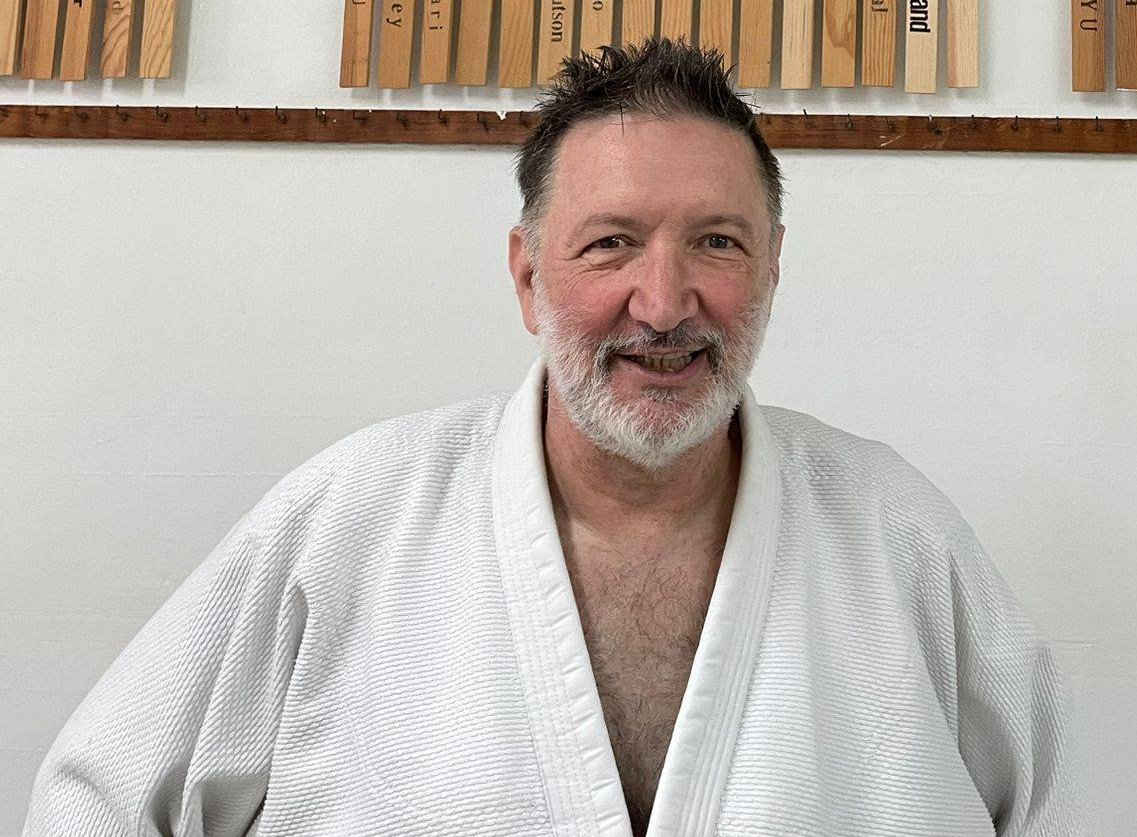
Modoru. An interesting Japanese verb. There’s iku (to go), kaeru (to return), and modoru
(to go back to whence you've just returned from). To re-return, or return again? I know of no other language that needs
a verb for this. Anyway, shoshin ni modoru is a sentence you often hear in the Japanese martial arts scene or
read in scrolls in dojos: “always go back to the spirit (literally, the ‘heart’) of the beginner”.
Here is my take on that in more than a few words. You wouldn't guess if you ever saw me on the mat but I've been practicing
martial arts for almost 50 years. I started in the mid-70s practicing Shotokai, a fringe Karate style which is an
offshoot of Shotokan, using mostly the same syllabus, but ergonomically very different, that happened to be popular in Portugal,
where I come from. Back then, most people thought Karate was about breaking bricks and pieces of wood with your hands.
You see, until 1974, the martial arts were forbidden in Portugal, Judo excepted, and you needed a special permit
from the Interior Ministry to practice, which was only given to the police and armed forces.
After 1974, with the reestablishment of democracy, things opened up and martial arts were one of many things Portugal
caught up with. Around 1976 the Budo Academy was founded in Lisbon, as a group of Japanese instructors introduced a number
of thither-to unknown disciplines: Goju Ryu, Kendo, Shorinji Kempo, and others. I decided to try Goju Ryu. A couple of years
later Sporting Lisbon, which soccer fans will know as a big soccer club but is also a multi-sport club offering everything
from basketball to swimming, inaugurated its Taekwondo section, specifically ITF Taekwondo, to grossly oversimplify, a Korean
version of Shotokan, a bit different from the WTF Taekwondo you see on the Olympics and so on. I left Goju-Ryu - because
the Japanese teacher went back to Japan and left behind as dojo-cho a young Shodan who freely admitted he couldn’t but repeat
what we all had already seen and done - and moved to Taekwondo. That can be said to have been my alma mater, as I
spent over ten years practicing about 2/3 hours a day 5 days a week. I know now two things I didn't know then:
(i) it was a privilege to practice in a club that had two dojos (in Korean, dojang) with separate classes for white belts,
beginners, intermediate, black belts, competition and children, everyday from 5.00 to 10.00 PM; on average, over 200 people
would come practice daily, a rarity anywhere in the martial arts world, and
(ii) it was not really a martial art, rather a performative combat sport, push ups, sit ups, splits, bouts, etc. etc.
Sometime around the mid-80s the dojang had to close for a few months in the summer for refurbishment. I couldn't contemplate
such a long period of idleness so I decided to try boxing. I learned a few things. Namely, there’s three types of boxing gloves:
small ones, a bit like ski mittens, which you use to punch the bag; normal ones, which you see in matches, and big ones, which
you use for sparring, when you are supposed to pull your punches a bit. What happens is, if you hold your guard like in
Japanese you’d say jodan no kamae, you don't see a thing because you have two objects the size of watermelons in front
of your eyes. If you remove them from the front of your eyes, that's the precise moment you get punched in the nose. Interestingly,
I realized that the first time I opened my guard, but it took at least seven or eight punches in the nose for me to change my
reflexes and try to defend myself otherwise, namely by ducking or turning my back, which I was then told was against the rules.
Rules. What kind or rules are those that make it hard for you not to get punched in the nose? In the meantime, my hot shot black
belt rep melted before everyone’s eyes, mine excluded as they were closed on account of me having been punched in the nose. But
I persevered and I think I managed to weed out some of the most blatant inadequacies till around October, when the dojang
reopened and I quit boxing and went back to Taekwondo. I haven’t been punched in the nose much since, so in hindsight that
wasn't a bad decision.
In the late 80s, in the aftermath of the Seoul Olympics, the dojang moved from ITF to WTF and I was invited to join the
competition team. I learned one thing: competition training is bo-horing! You can forget about 90% of what you think you
learned in standard practice. If your left roundhouse kick or some other technique happens to be good, they turn you into
a one trick pony and have you do cardio, jump rope and kick the bag until you forget there was ever a life beyond that.
I dropped out after a year or so.
In 1994 I moved to Tokyo and went back to Goju Ryu. I made two mistakes
(1) being Caucasian and
(2) telling them I used to do Taekwondo, which the Japanese regard as a mongrel Korean corruption of all that is pure and
true in Karatedo. So they beat me up. At first I thought “wow, this is the real deal”, but then I realized I was the only one
being beat up, so I thought “OK, this must be a rite de passage thing, to test my resolve”, but as the weeks and
months went by and everyone was cold, borderline rude, to me I realized they didn't want me there and obliged.
In 1999 I moved to New York. The Midtown YMCA was across the street from my office and they offered classes of Shukokai,
a sort of Goju-ryu/Shito-ryu mix, so I tried that. The teacher realized I'd done Karate before and asked me about my background,
so about a year later he suggested I test for free-style Shodan, which I had never heard of. I said sure, so a few months later
we all go up to Albany, where a yearly event took place and the dan tests were conducted. I asked what was expected of me and my
teacher said “don't worry, just do what your are told”. The test consisted of about five minutes of the jury calling for
kihon waza for you to do, then renzoku waza you should improvise, a kata of your choice and finally two one minute or so
bouts of kumite. In the end, me and everyone else passed.
“Congratulations,” I was told, “that'll be 450 dollars.”
“What?” I asked, “Yes, its 250 dollars for the dan certificate, 50 for the dan book” etc. etc.
“Er, I don't have 450 dollars with me.”
“That's OK, you can pay when you get back to New York”.
I am not sure they ever saw me again, but I never saw them.
Which brings me to 2008, Berlin and finally Aikido. Ever since the 70s I had been told multiple times Aikido is the thing,
you should try it, etc. etc. and I believed it, it’s just Aikido isn't exactly around every corner if you don't go look for it
and while you're busy pursuing other interests the years go by. It just so happened that right next door to where I lived there
was a dojo with huge red neon letters saying AIKIDO. So I decided to go in one day. When waza practice started, Christoph,
the sempai, a Yondan, called me up. As we line up he asks “is this the first time you are doing Aikido?” (Germans use the present
continuous, funny) “Yes, first time.” “Is it really your first time?” “Aikido yes, but I do other stuff, Karate and so on”.
“I can see that” he replied. “Hmmm” I thought, “he is on to my ninja aura... I must practice to become even stealthier”.
The first technique I tried was aihanmi katatedori ikkyo. There's an equivalent technique in Wado-Ryu, which I was also
doing at the time – Wado being a ju-jitsu inflected Karate style, I though Aikido would be a good complement. Christoph kept
pointing out to me obvious stuff I never knew: “wrong arm”, “right arm, wrong foot”, “if you get stuck, don't push forward,
move your hip back”, and so on.
From that day on, I was hooked. Eventually I dropped Wado Ryu to concentrate on Aikido. A few years later I moved to Beijing,
not the best place on earth to practice Japanese martial arts. Many Chinese have a thing about Japan, but in Beijing more so.
It is not uncommon to find organizations, from amateur theater groups to poker clubs, which proudly protest to be patriotic,
communist and anti-Japanese. Anti-Japaneseness is a civic virtue in those parts. But I did find a dojo, run by an American
Godan who spent several years at Hombu Dojo, William Gillespie Sensei. I remember him, walking back and forth on the mat,
saying “you can't come back here day after day and make the same mistakes over and over again!”. I'm mortified to report he
was wrong.
Then it was back to Portugal, at Isshin dojo, with João Tinoco Sensei, Godan, who also taught Shindo Muso-ryu Jodo. And
eventually back to New York, where I had the privilege of practicing just over a year under Yamada Sensei. The dojo was eight
blocks from where I lived, so I got to go five or six times a week. I learned the hours you put in make a considerable
difference on how Aikido sinks in. Morning practice the day after Yamada Sensei's demise was announced had a vibe like I never
felt before or after.
And for the last year I’ve been practicing at Providence Aikikai, under David Halprin Shihan and Dare Matheson Shidoin, trying
to learn the Shin Kaze way. Some things I actually find easier, like the slide-step approach to basic technique, it gives you
another half second to brace yourself. On the other hand, for ushiro ukemi I’m thinking of hiring a double.
So there. It's the way it goes. Sometimes you practice and practice and feel you’re stuck, then one fine morning you wake up
to find you grasped something that eluded you for years, a dim light at the end of the tunnel.
I'll keep following it.
|
|
Art. 5
A Movement to Resist
By Michael Aloia
Dojo-cho Asahikan Dojo, Collegeville, PA
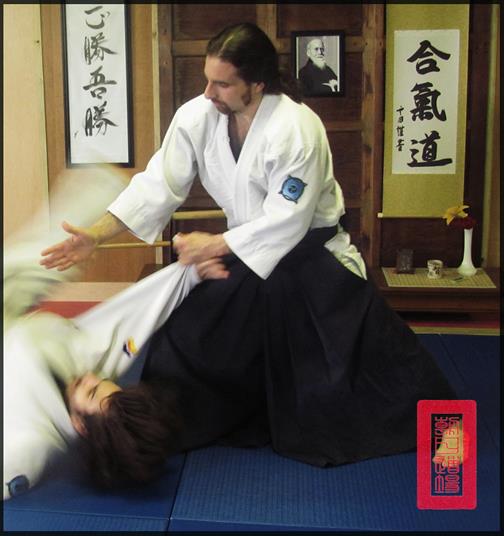
Resistance can simply be defined as an opposing force. Something, big or small, that in some way, conflicts with our current state of being and doing; hindering us from seeing things clearly and or moving forward. This resistance can be real or imaginary based on our perception and perspective of any given situation. Resistance can come from outside sources as well as from within us. More often than not, when we take time to reflect, we may find that the root or cause of the initial resistance is from within - us, standing in our own way because of some level of fear which is creating doubt, mistrust and in the long run, anger.
Movement is the ability to move from one place to another. Movement, then, can be looked at as the counter measure to resistance; movement in mind, movement in body, and movement in spirit. Movement ensures we are a not a sitting target and creates options and opportunity to avoid, diffuse, and overcome the obstacles of resistance. Movement provides forward thinking as well as awareness of our own and others’ emotions and environments. This forward thinking concept affords us levels of personal control giving us the means needed to make the right decisions and helps put us in the right place at the right time.
Both resistance and movement are created by energy. Energy is a force that propels not only physical objects but things that exist on an emotional, mental, and spiritual plane as well. Energy is neither good nor bad, it just is. Intention is what gives energy the context of good or bad. Energy has always existed and can never be completely canceled out. It can, however, be altered or modified, moving it into a new space, a new form, and a new intent. The energy from one intention can fuel the energy of another if given the right focus and the concentrated effort. A bad situation can be made good as a good situation can be made bad. It is all based on intent.
Momentum is what gives energy its power. Momentum is a gathering of force, a collection of intent and belief. Momentum can quickly build, much like a snowball builds size and speed as it rolls down a snow draped mountain side – picking up what’s around it. Energy does the same as it assimilates the intent surrounding it. Laughter is contagious and on the flip side, misery loves company.
Energy and intent are powerful. Together, they can be the perfect storm. How we choose to harness and hone energy is all based on our intent. Is it for the greater good or the lesser? To resist resistance, we must look to move to avoid being so anchored that we cannot see what lies ahead and what still may lurk behind. Movement puts us in the now and keeps our intentions in the moment as the past is the past and the future is based on what we make of the present in each given moment… with each given movement. Movement is momentum with a purpose, putting energy and intent to use, giving us the power to manage what we encounter. This level of ability will always give us the capacity to remain centered and balanced, keeping our intentions pure and our movement fluid and continuous.
|
|
Art. 10
Dojos granted Full Member status
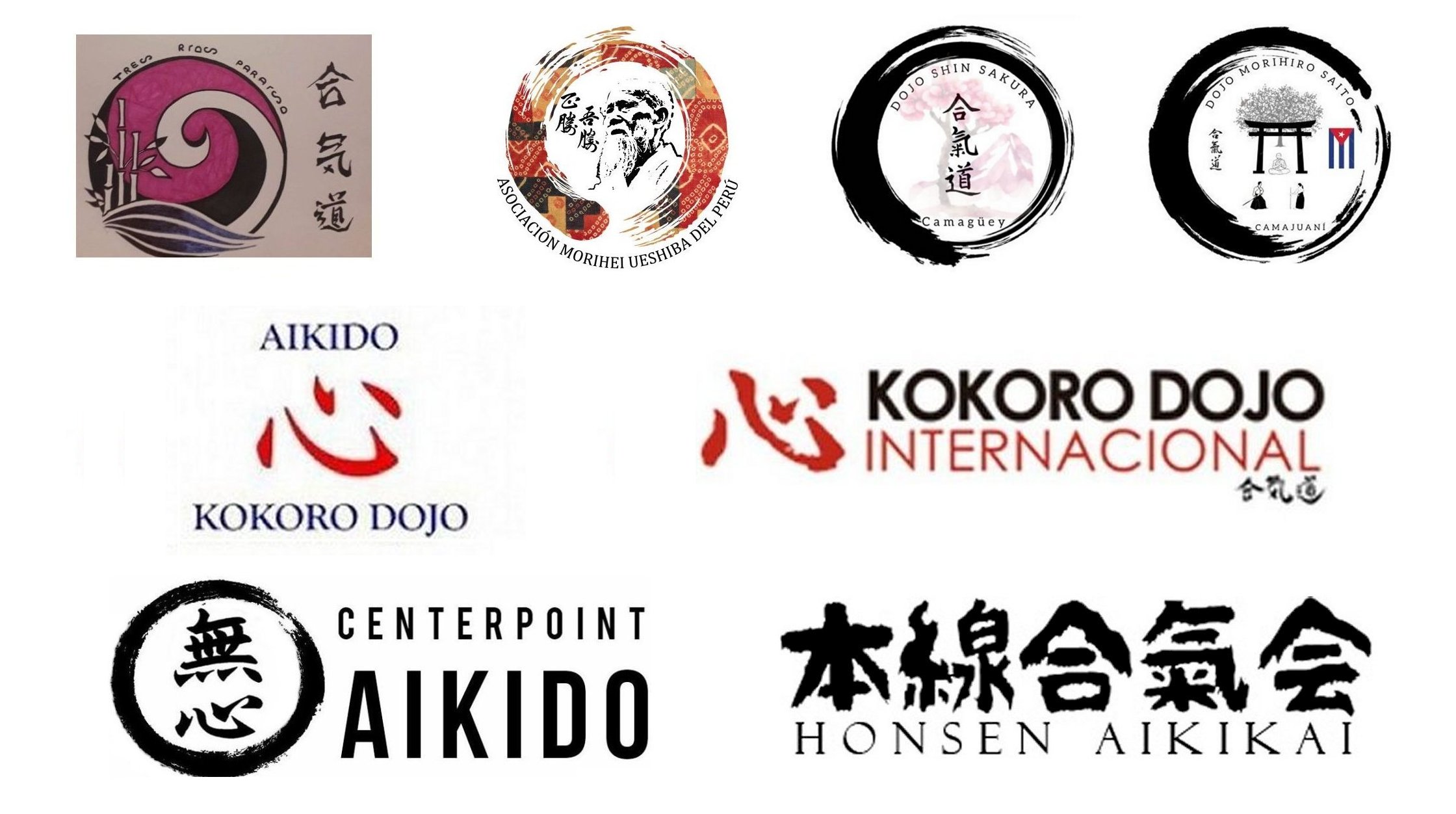
We are pleased to announce that the following dojos have been granted Full Member status:
- Tres Ríos Paraíso Aikikai, located in the city of Puerto Quito, Ecuador, led by dojo-cho Allen Kline, nidan.
- Niji Dojo - Asociación Morihei Ueshiba del Perú, located in the city of Lima, Perú, led by dojo-cho Miguel Antonio Morales-Bermudez Shihan, nanadan.
- Dojo Shin Sakura, located in the city of Camagüey, in the state of Camagüey, Cuba, led by dojo-cho Alexis Botiel Fernandez, nidan.
- Morihiro Saito - Kan Sho Ryu Dojo, located in the city of Camajuaní, in the state of Villa Clara, Cuba, led by dojo-cho Michel Casanova Casanova, nikyu.
- Kokoro Dojo, located in the city of Córdoba, in the Province of Córdoba, Argentina, led by dojo-cho Daniel Medina, rokudan.
- Associació Andorrana D'Aikido - Kokoro Dojo Internacional, located in the city of Andorra la Vella, in Andorra, led by dojo-cho Diego Alberto Lozza, shodan.
- Center Point Aikido, located in the city of Toms River in New Jersey, USA, led by dojo-cho Craig Johnson, shodan.
- Honsen Aikikai, located in the city of Narbeth in Pennsylvania, USA, led by dojo-cho Andrew Benioff, sandan.
Congratulations!
|
|
Art. 11
Aikido for Children and Teenagers
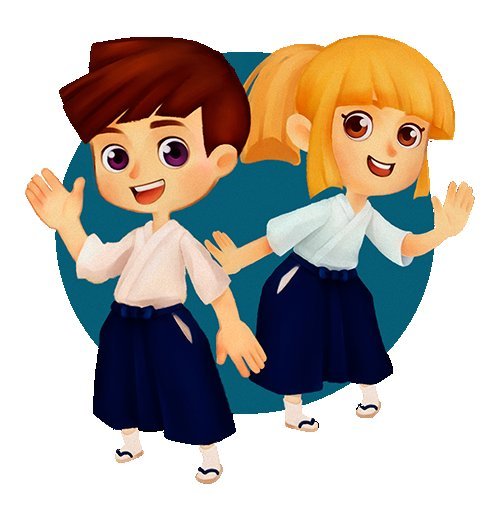
Starting with this issue, we are introducing a section on “Aikido for Children and Teenagers,” in which one or more young practitioners share their thoughts and favorite aspects of Aikido.
Meet 4-year-old Aki, who has been practicing for 3 weeks, but has attended every class for the past 3 years and has watched the classes intently from the edge of the mat. Finally, he has become old enough to join in.
After his first class, Aki spontaneously said, I love kids class. I like the dragon/snake movement.”
One of our young journalists interviewed Aki, who wanted to share the following with us:
Aki-chan, why did you want to start practicing Aikido?
- I watched for a long time and waited until I was old enough to start.
What is your favorite technique?
- I like the snake/dragon (and at that moment Aki stands up, runs forward, does a tenkan and says) "...and when you take the jo."
Are there classes for children and/or teenagers in your dojo? Please contribute to this new section of the newsletter by sending short pieces from children or teenagers themselves! |
|
Art. 13
Reporting Aikido Injuries
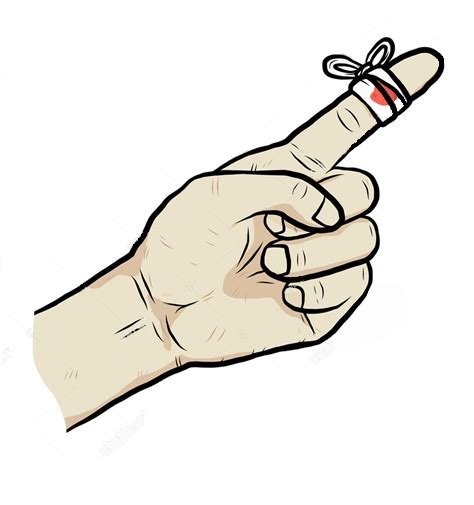
Safety in Aikido practice is paramount, and a systematic approach to safe practice should always be observed
to minimize occurrence of injuries. However, even with the best of intentions and practices, injuries do occur
at times in Aikido, as in any martial art or physical activity.
To keep a record, identify and correct unsafe practices in Shin Kaze, a database was set up in mid-2022
for dojo-cho to record injuries as reported to them by their students. Fortunately no injuries have been
reported to date, but this may be because the dojo-cho were not informed. To streamline the reporting process
and make it more widely available, as of October 2023 all Shin Kaze members can report injuries anonymously.
To report an injury first log in to the Shin Kaze web site or register as a new user. Once logged in click on
the ADMIN tab on the top menu and then on the "Injury Report" tab on the left hand side. The "Aikido
Injury Report Form" will be displayed on the right and you will be able to create an injury report.
Hopefully there will be no injuries and there will be minimal use of this database.
|
|
Art. 12
Lorem ipsum
By/Por Author Name
Dojo-cho Dojo Name, Country/Pais
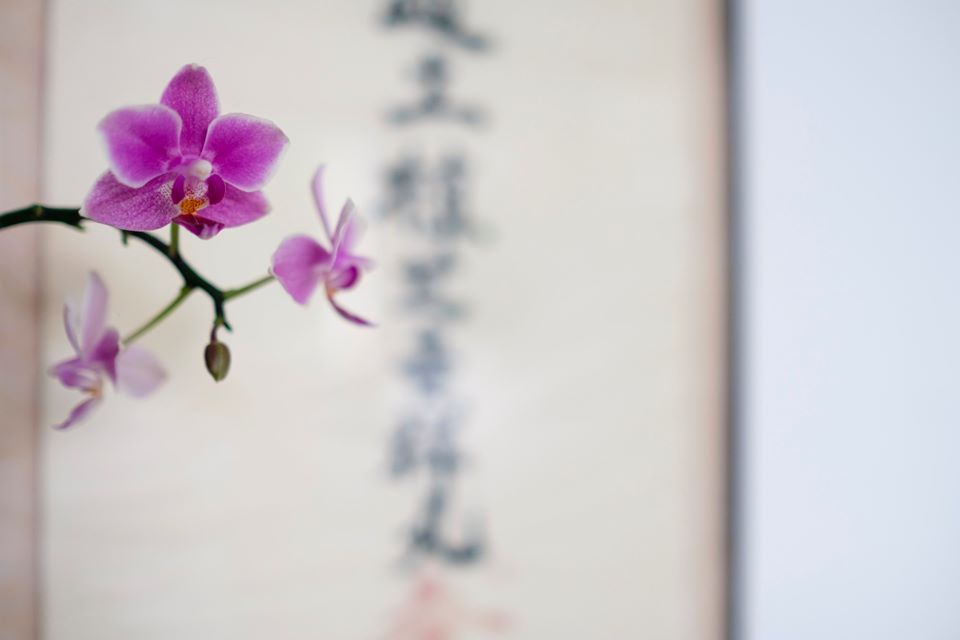
Lorem ipsum dolor sit amet, consectetur adipiscing elit, sed do eiusmod tempor incididunt ut labore et dolore magna aliqua. Ut enim ad minim veniam, quis nostrud exercitation ullamco laboris nisi ut aliquip ex ea commodo consequat. Duis aute irure dolor in reprehenderit in voluptate velit esse cillum dolore eu fugiat nulla pariatur. Excepteur sint occaecat cupidatat non proident, sunt in culpa qui officia deserunt mollit anim id est laborum
Sed ut perspiciatis unde omnis iste natus error sit voluptatem accusantium doloremque laudantium, totam rem aperiam, eaque ipsa quae ab illo inventore veritatis et quasi architecto beatae vitae dicta sunt explicabo. Nemo enim ipsam voluptatem quia voluptas sit aspernatur aut odit aut fugit, sed quia consequuntur magni dolores eos qui ratione voluptatem sequi nesciunt. Neque porro quisquam est, qui dolorem ipsum quia dolor sit amet, consectetur, adipisci velit, sed quia non numquam eius modi tempora incidunt ut labore et dolore magnam aliquam quaerat voluptatem. Ut enim ad minima veniam, quis nostrum exercitationem ullam corporis suscipit laboriosam, nisi ut aliquid ex ea commodi consequatur? Quis autem vel eum iure reprehenderit qui in ea voluptate velit esse quam nihil molestiae consequatur, vel illum qui dolorem eum fugiat quo voluptas nulla pariatur?
|
|
Art. 14
Lorem ipsum
By/Por Author Name
Dojo-cho Dojo Name, Country/Pais

Lorem ipsum dolor sit amet, consectetur adipiscing elit, sed do eiusmod tempor incididunt ut labore et dolore magna aliqua. Ut enim ad minim veniam, quis nostrud exercitation ullamco laboris nisi ut aliquip ex ea commodo consequat. Duis aute irure dolor in reprehenderit in voluptate velit esse cillum dolore eu fugiat nulla pariatur. Excepteur sint occaecat cupidatat non proident, sunt in culpa qui officia deserunt mollit anim id est laborum
Sed ut perspiciatis unde omnis iste natus error sit voluptatem accusantium doloremque laudantium, totam rem aperiam, eaque ipsa quae ab illo inventore veritatis et quasi architecto beatae vitae dicta sunt explicabo. Nemo enim ipsam voluptatem quia voluptas sit aspernatur aut odit aut fugit, sed quia consequuntur magni dolores eos qui ratione voluptatem sequi nesciunt. Neque porro quisquam est, qui dolorem ipsum quia dolor sit amet, consectetur, adipisci velit, sed quia non numquam eius modi tempora incidunt ut labore et dolore magnam aliquam quaerat voluptatem. Ut enim ad minima veniam, quis nostrum exercitationem ullam corporis suscipit laboriosam, nisi ut aliquid ex ea commodi consequatur? Quis autem vel eum iure reprehenderit qui in ea voluptate velit esse quam nihil molestiae consequatur, vel illum qui dolorem eum fugiat quo voluptas nulla pariatur?
|
|
Art. 15
Lorem ipsum
By/Por Author Name
Dojo-cho Dojo Name, Country/Pais

Lorem ipsum dolor sit amet, consectetur adipiscing elit, sed do eiusmod tempor incididunt ut labore et dolore magna aliqua. Ut enim ad minim veniam, quis nostrud exercitation ullamco laboris nisi ut aliquip ex ea commodo consequat. Duis aute irure dolor in reprehenderit in voluptate velit esse cillum dolore eu fugiat nulla pariatur. Excepteur sint occaecat cupidatat non proident, sunt in culpa qui officia deserunt mollit anim id est laborum
Sed ut perspiciatis unde omnis iste natus error sit voluptatem accusantium doloremque laudantium, totam rem aperiam, eaque ipsa quae ab illo inventore veritatis et quasi architecto beatae vitae dicta sunt explicabo. Nemo enim ipsam voluptatem quia voluptas sit aspernatur aut odit aut fugit, sed quia consequuntur magni dolores eos qui ratione voluptatem sequi nesciunt. Neque porro quisquam est, qui dolorem ipsum quia dolor sit amet, consectetur, adipisci velit, sed quia non numquam eius modi tempora incidunt ut labore et dolore magnam aliquam quaerat voluptatem. Ut enim ad minima veniam, quis nostrum exercitationem ullam corporis suscipit laboriosam, nisi ut aliquid ex ea commodi consequatur? Quis autem vel eum iure reprehenderit qui in ea voluptate velit esse quam nihil molestiae consequatur, vel illum qui dolorem eum fugiat quo voluptas nulla pariatur?
|
|
Dear Dojo-cho and Supporters:
Please distribute this newsletter to your dojo members, friends and anyone interested in
Shin Kaze Aikido Alliance.
If you would like to receive this newsletter directly, click
here.
|
|
|

|
SUGGESTION BOX
Do you have a great idea or suggestion?
We want to hear all about it!
Click
here
to send it to us.
|
Donations
In these difficult times and as a nonprofit organization, Shin Kaze welcomes donations to support
its programs and further its mission.
Please donate here:
https://shinkazeaikidoalliance.com/support/
We would also like to mention that we accept gifts of stock as well as bequests to help us build
our Shin Kaze Aikido Alliance endowment.
Thank you for your support!
|
|
|
|
|
|
